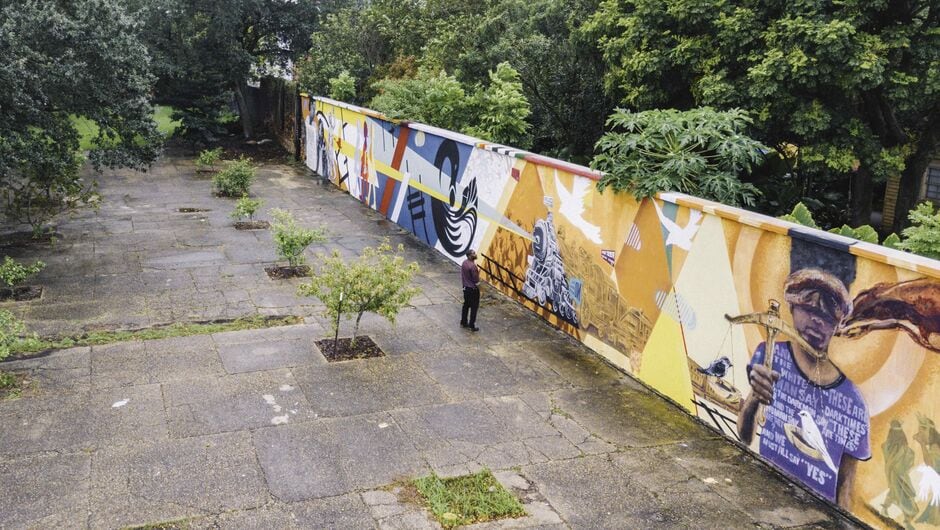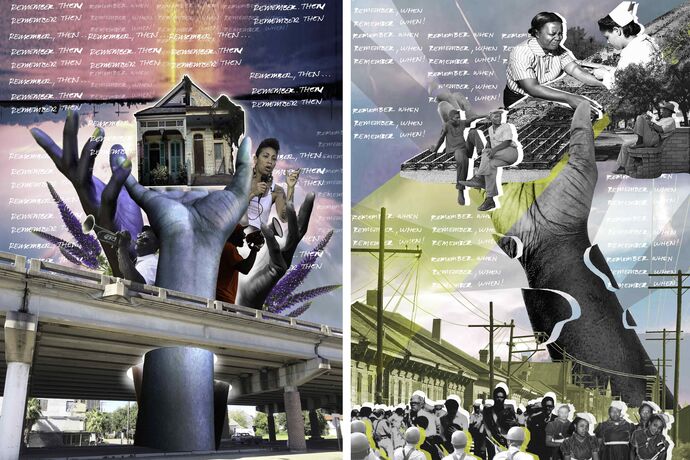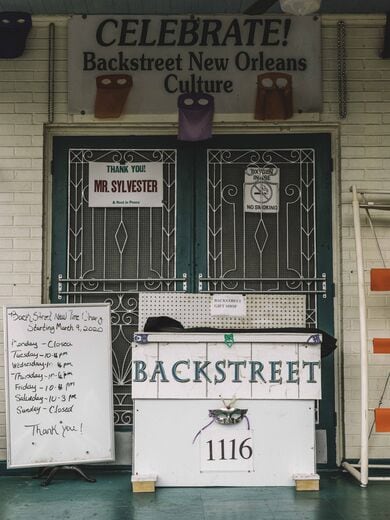
A Just Future Might Require a Radical Redesign of Where Students Learn
'For literally every injustice, there is an architecture planned and built to sustain and perpetuate that injustice,' says one architect who believes buildings can facilitate liberation.
Bryan C. Lee Jr. is an architect and designer in New Orleans who sees the world differently from most of us.
When he looks around New Orleans at the built environment, he doesn’t just see the buildings. He sees the intentions of the people with money and power who designed and built neighborhoods and structures, like schools and courthouses, 100 or 50 or 20 years ago. He sees how the buildings themselves often perpetuate racist ideologies and systems that continue to forfeit the futures of generations.
Global warming, racial segregation, mass incarceration—all are facilitated by the built environment. “For literally every injustice,” Lee says, “there is an architecture planned and built to sustain and perpetuate that injustice.”
In 2017, around the same time that four Confederate monuments were taken down in New Orleans, Lee co-founded a nonprofit firm called Colloqate Design dedicated to what he calls designing for justice. That’s a practice that elevates culturally-responsive design, by and for members of communities who have been excluded, erased, or suppressed through white-dominant power structures.
Designers for justice use architecture to bring out the histories and cultures of the communities where they work. They design built environments that express the people who live there: how they gather and move around spaces, how their aesthetic vibe speaks, whose stories they want to tell. Lee and like-minded colleagues are trying to achieve in architecture and design what many educators and allies are trying to achieve in their own field: to redistribute power and fundamentally change inequitable systems that are perpetuating inequities and damaging lives.

How Does a Building Perpetuate Injustice?
Architects design public buildings like machines: to make things easy and encourage consistent, replicable behaviors within a structure of power and control.
Take courtrooms. If you’ve ever been in one, you immediately understand the accused person’s relationship to everyone in the room, and how that person is dominated by the jury and the judge who sits in the elevated seat of power.
Now picture a standard school building (like one of the Romanesque hulks in many inner cities, the mission-style schools in the West, or the newer and shinier metal and concrete boxes that resemble mini-mansions in gentrifying neighborhoods). The average American school is 44 years old. Consider the patterns and behaviors the building enforces.
The classroom is rectangular, designed for desks to be arranged in columns. There are windows on one side, usually the left, so the right hand can write without creating a shadow. The instruments of teaching are at the front, where a teacher can present information to as many students as can fit into rows. Classrooms are arranged along hallways with tall, skinny doors, each containing a single skinnier window.
These are rooms of isolation in factory-like buildings, designed for order and efficiency. Like hospitals and prisons, they’re built to dictate routines, enforce habits, and create standard and replicable experiences that deliver standard outcomes with the least amount of friction. They feel different from building typologies rooted in empowerment and self-direction, like some libraries that are laid out to encourage discovery and museums that invite people to move at their own pace according to their own volition.
Perhaps naturally, in New Orleans, many educators are allies with designers for justice, collaborating within a big, free-form community of racial justice activists, artists, historians, neighborhood leaders, politicians, and youth leaders working to shape the city’s future. Some of the most active members work in the only public buildings that almost everyone within a community touches: the schools.
Lee has brought his theory of systems change to workshops with Teach For America corps members. Most recently, he facilitated a discussion with Black educators at a gathering by Black Education For New Orleans (BE NOLA), an organization committed to supporting Black teachers and Black-led institutions to achieve educational excellence for Black students.
BE NOLA’s founder and executive director is Adrinda Kelly who attended McDonogh 35 (New Orleans’ first high school for Black students) and went on to study at Harvard University. Kelly hopes educators take inspiration from Lee’s approach to design justice. “We have to do our part to push each other’s imagination and the imagination of our ecosystem around ways to do schooling differently to serve Black children in the way they deserve to be served,” Kelly says.
Lee, for his part, hopes educators like those who came to BE NOLA’s Black Brilliance Education Summit will become “design advocates” who interrogate how buildings influence outcomes and question who has the power to design. Basically, wherever people are having conversations about changing systems—schools, criminal justice or others—Lee wants them to consider the impact of architecture.
Especially right now.
For more than three decades, educators and communities have joined a concerted effort to achieve better and more equitable learning outcomes. While school and district leaders have come and gone, and policies, tests, and curricula have shifted, the spaces where these changes occurred often stayed the same. What if part of what’s holding us back is the “hardware” to the software of curriculum. That is, what if part of the problem is the way that schools are built?
Asya Howlette (S. Louisiana ’12), was a candidate for New Orleans Parish School Board this past fall and led the New Orleans chapter of The Collective, TFA’s association for alumni who identify as Native, Indigenous, and people of color. Howlette has visited private schools and has seen for herself the difference the “hardware” makes in buildings that are bathed in natural light from walls of windows. She’s seen students move through indoor and outdoor collaborative spaces surrounded by projects and artwork.
“It was like a kid museum,” Howlette recalls, comparing one of those schools to the classrooms where she’s taught for nine years in Baton Rouge and New Orleans. “And then for us, it’s like, oh, here’s four walls and a door. Make it work.”
In the great pandemic of 2020, millions of students and educators have been forcibly released from their school buildings. “COVID is offering another forced reimagining,” BE NOLA’s Kelly says.
There may be no better time than now to consider how we redesign these built environments for justice, self-determination, and student-led learning. Lee suggests, “If we want to get a new outcome, we need to build a new typology.”

Resisting Complicity
Lee was still a boy when he had the epiphany that started him on the road to designing for justice. As a military kid, he’d experienced the regimented culture of living on bases designed to maintain hierarchy and enforce discipline. He’d also experienced life in the town of Comiso, Sicily, where tight streets and open plazas encouraged walking and visiting.
Then, when he was 12, his family moved to live with his grandmother in her 15-foot-wide row house in Trenton, New Jersey. Every day, he watched his grandmother painfully climb a steep, dark staircase through the center of her house, her knees aching with age.
Why did his grandmother have to live in a house that hurt her, he wondered, in a place where she was stranded without driving? He thought back to the ease of Comiso and told his parents he wanted to design a home for his grandmother that wouldn’t cause her pain. His parents told him he was describing the work of an architect.
He chose to attend college in Columbus, Ohio—following in his father’s footsteps and staying close to his role model, Curtis J. Moody, a pioneering Black architect and founder of the largest Black-owned architecture firm in the country. But Lee’s classes often conflicted with his goal of venerating Black culture and history. He remembers getting an assignment to design a science center that Columbia University could build in Harlem. “It felt like we were dropping spaceships on these communities without even asking them what they wanted,” he says. “It felt wrong.”
Seeking inspiration, he borrowed a video camera from school and commenced to travel across the country, filming interviews with all six finalists to design the National Museum of African American History and Culture in Washington, D.C. He was excited by how the winning architects, including David Adjaye, Philip Freelon, and J. Max Bond Jr., incorporated into the building a familiar architectural feature from the Black diaspora: a big front porch. In every facet of the building, Lee says, they “mapped the narratives and stories of Blackness onto architecture at scale.”
Emerging from graduate school, Lee joined a New Orleans firm where one of his first projects was renovating the school that young Ruby Bridges integrated. “That’s where I learned to be an architect. I was happy. It was a good firm made up of nice white people.”
While working at the firm, Lee made time to bring architecture lessons into classrooms through Project Pipeline, a program of the National Organization of Minority Architects which puts under-represented students on a path to getting interested in architecture. While visiting schools two or three times a week, he evolved it into summer camps and semester-long and year-long programs where now, Lee estimates, about 1,500 New Orleans students have learned how to practice design justice.
He went on to lead the national Project Pipeline youth program while building his network among New Orleans activists. But when Eric Garner and Michael Brown Jr. were killed at the hands of police in 2014, he faced a crisis. Working at his firm, “I didn’t feel like we were meeting the moment, and I didn’t think we’d ever be able to meet the moment … I felt disconnected from my people, unable to be of service, to use my skillset to serve my community.” He left to join the Arts Council of New Orleans, where he ran a new civic design department. From there he co-founded Colloqate.
Colloqate is probably best known for the Paper Monuments project. After New Orleans took down prominent Confederate monuments, Mayor Mitchell Landrieu and the city commissioned Colloqate to solicit proposals from city residents for monuments that would represent all the strands of New Orleans’ 300-year history.
To do this, Colloqate ran a public proposal process through which they collected thousands of submissions. Residents proposed building monuments to football coaches, their mothers, Katrina victims, and lifesavers. They also brought forward the lesser-known histories of people like the San Malo Maroons, the remarkable community of people who escaped slavery, led by Juan San Maló.
Colloqate then brought together local historians, poets, artists, students, and educators to design 50 posters that they installed in public places from the river to the lake. They organized education and art events for residents to engage with these local histories. For Lee, it was the vision of design justice come to life. “It truly represented the voice of the people.”
Kelly sees parallels between the Paper Monuments project and the work of Black educators through BE NOLA. Paper Monuments told multiple stories of local history. “I think also of our work, which is to rupture this idea that there is a single story of New Orleans education, a single story of failing schools, of incompetent teachers, etc.,” Kelly says. “Actually there are many stories that contribute to the challenges and to the possible solutions for the moment that we’re in. And our job is to elevate examples of stories of Black educators, like Dorothy Mae Taylor, who have something to offer as we think about the root causes of the challenges we face and the possible solutions.”
Taylor, an activist PTA leader who fought 60 years ago for Black students to get equal resources from New Orleans Parish, was the subject of the seventh Paper Monuments poster.

Designing a New School Typology
When Lee starts any project, he asks himself: What are the conditions people are dealing with? How do they see themselves in relation to those conditions? And which conditions are rooted in some system of oppression? He looks at who has the power, who is most marginalized, and how that shows up in the physical environment.
For educators who don’t have the budget to renovate or build new schools, Lee suggests giving students more power over space. Great educators already do this: cede their walls to student artists, turn their classrooms into museums, change furniture groupings, give students options of where and how to do their work in and out of the building. “It doesn’t solve everything,” he says, but “there’s a simple psychology” to physical liberation and having control of one’s environment. “And ultimately, it makes an impact.”
Teachers can consider using the full footprint of the school building and grounds. Commandeer large communal spaces. Move kids outdoors. And when there are opportunities to rebuild or build new, teachers can challenge architects and planners to start with community self-determination, as they think about who will actually use that building for a half century or more.
Educators can democratize the space. Lee envisions building schools that have double or triple the communal spaces of old school buildings. He worked on a project at College Track New Orleans where his firm collaborated with students to redesign a section of the building. They built hallways that included nooks with benches and chairs, not the standard school “cattle shoots” that encourage the quick movement of bodies down hallways.
Educators can physically connect to communities. No more schools built like fortresses where the clear visual message is: Community stay out. That sounds counterintuitive at a time when schools have to fortify against shooters. What if schools distributed themselves in smaller buildings like on a college campus? “Communities are what actually keep us safe,” Lee says.
Educators can connect buildings to history. Schools, especially high schools, serve as anchors to their communities. The importance of that link has been made clear in New Orleans recently as a number of schools managed by charter organizations have reverted to the buildings’ original names: Booker T. Washington, Frederick Douglass, and Thurgood Marshall. Educators can use their building walls to tell stories of the people who made local history.
Lee cites the example of the 5,300 Rosenwald schools that were built for Black students, by and with Black communities across the south, when their children were banned from going to school with white children. Asya Howlette suggests that newly designed schools could “represent the vision that we have for ourselves,” not a vision white architects have for Black students. “We’ve done it before.”
Finally buildings can show an appreciation (which most schools lack) for the day-to-day visual language of their neighborhoods. They can communicate through their design that they value the cultures families carry and the languages they speak—Lee calls this “colloquial design” and it’s where the “q” in Colloqate comes from. He points to places like New Orleans’ Backstreet Cultural Museum, which “resonates with people on a cellular level … Oftentimes you’ll see people connect to spaces and they won’t know why, but they’ll be there because it’s got a vibe.”

Design as Protest
This past June, after the killings of George Floyd and Breonna Taylor, the design justice community that Lee and Colloqate have been cultivating in New Orleans swelled with new members.
For years, Colloqate has been facilitating a workshop called Design As Protest (DAP). Suddenly hundreds of designers, organizers and youth from across the country began reaching out to sign Colloqate’s Design Justice Demands, attend DAP workshops, and invite Colloqate to present and lead design justice teach-ins.
Colloqate is now partnering with organizers and activists across the country to help communities erect their own memorials to those who have “lost life, land, and futures,” Lee says. This fall, 20 memorials are in the works honoring the lives of Breonna Taylor, George Floyd, and Ahmaud Arbery as well as Mia Green and Dominique “Rem’mie” Fells, who were killed this summer in Philadelphia in an epidemic of murders of Black trans women, and more.
In the meantime, DAP has become a national collective that hosts virtual events and days of action for anti-racist designers and weekly gatherings for BIPOC (Black, Indigenous, and People of Color) designers. And Lee remains committed to working with youth. Over the summer he worked with students to imagine new typologies for public safety departments in place of police departments. “It’s important to visualize what might be on the other side,” Lee says.
In the end, Lee says, teaching may be what his collective does best. So students and educators from anywhere are invited to join. “Design justice,” he says, “requires us to be in community.”
Sign up to receive articles like this in your inbox!
Thanks for signing up!
Content is loading...



